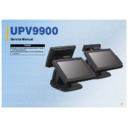Sharp UP-V9900 (serv.man3) Service Manual ▷ View online
2-16
Using BIOS
Introduction
Expansion
Installation Locations Connecting Peripheral Devices
Turn On and Off the System
Restoring HDD Drive to factory default configuration
Setting
Appendix A Appendix B
Troubleshooting
Supporting OS : Windows XP(Embedded)/ Windows XP Pro/WEPOS
Barcode Scanner
Cash Drawer
VFD (Line display)
MSR (Magnetic Stripe Reader)
Supporting Peripherals
The driver is installed on the hard disk at the factory before delivery.
Path : C:\Valcretec\Drivers\OPOS_Driver
The Installation Location of the OPOS Driver
Introduction OPOS Driver
The current OPOS driver has been developed in accordance with OPOS Specification Version 1.12 and continues to support the OPOS version.
OPOS Driver released executive file format for easy installation. Just run “Setup.exe” for installation. During OPOS Driver installation, all of
components are automatically registered and set up properly for system composition. It does not need additional set up process.
Installation Method
Please refer to Readme.txt file in the installation file for the detail.
2-17
Using BIOS
Introduction
Expansion
Installation Locations Connecting Peripheral Devices
Turn On and Off the System
Restoring HDD Drive to factory default configuration
Setting
Appendix A Appendix B
Troubleshooting
POS Terminal Driver and Utility Introduction
The following drivers have been installed in the Valcretec folder on hard drive (C:)
Graphic
Contains video drivers.
OPOS_Driver
Contains various drivers used for the
POS terminal.
POS terminal.
Cash.Drawer.Driver
Contain cash drawer driver.
Audio
Contains audio programs and drivers.
Chipset
Contains Chipset drivers.
Touch Screen
Contains Touch Screen drivers.
LAN
Contains LAN drivers.
2-18
Using BIOS
Introduction
Expansion
Installation Locations Connecting Peripheral Devices Turn On and Off the System
Restoring HDD Drive to factory default configuration
Setting
Appendix A Appendix B
Troubleshooting
2-18
What restoring the Factory Restore Point does
Restoring HDD Drive to factory default configuration
Running this application overwrites current files on your hard drive. It is important that you understand the recovery process and the resulting file
loss. The results of the recovery process are irreversible, so be sure to review this section before proceeding.
FirstWare Recover Pro copies an image of the original factory hard drive onto your hard drive. The result is a hard drive in the same condition as
when you first purchased your POS—with an operating system (such as Windows), other system files, and often several software applications and
utilities.
During the recovery process, the hard- drive image overwrites everything currently on the primary hard drive. The drive will no longer contain any
files you have added, downloaded, or created on that drive.
If you have more than one hard drive, FirstWare Recover Pro affects only the primary drive (usually “C:”), which normally stores the system files.
This drive may also store user data files you have created, such as MS Word Files and graphic files.
Even though your primary drive is partitioned (divided into “C:” and “D:” drives, for example), you can’t select any partition and can’t restore C
drive only. The entire hard drive will be turned to the basic factory default status, so all applications and data that have been installed on the system
by a customer will be lost.
When the operating system is not bootable,or has become
unstable,you can enter the recovery mode to restore the system
to its factory configuration.
unstable,you can enter the recovery mode to restore the system
to its factory configuration.
▶ Review this section before running FirstWare Recover Pro.
Note!
2-19
Using BIOS
Introduction
Expansion
Installation Locations Connecting Peripheral Devices Turn On and Off the System
Restoring HDD Drive to factory default configuration
Setting
Appendix A Appendix B
Troubleshooting
When to revert to the Factory Restore Point Using
Use to revert to the factory image only when below situations have been happened:
● The system will not boot into the operating system. For example, Windows will not start up.
● The system has become unstable. This may be due to an operating system crash, scrambled hard disk, software worm, virus attack, or other problem.
When applications do not run properly, the cause may be an unstable system.
● Customer wants to return the hard drive to its original factory condition.
Click on the first or last page to see other UP-V9900 (serv.man3) service manuals if exist.

